Chester A. Reed, the Author and Pedagogue



Chester Albert Reed
Artist, Photographer, Writer and Naturalist (23)
1876 – 1912
Chester Albert Reed was born on January 10, 1876, in Worcester, Massachusetts. He was Charles and Carrie Reed’s second child.
At a young age, Chester showed an interest for bird studies and nature in general. He had a rare ability to share his discoveries with others.(1).
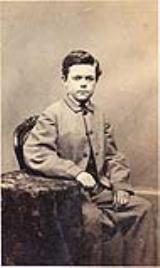
During his youth, probably around seven years old, he worked at his father’s store, where he learned the ropes of the a taxidermy profession. Just like his father, Chester showed a talent for drawing in his early years. With his mother’s encouragement, he kept developing his artistic talents. (P1)
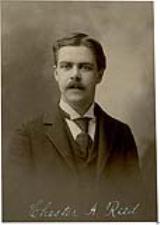
As a teenager, Chester attended a public school in Worcester. He graduated from the Worcester High School with honorable mention.(21) In 1896, he received his diploma as an electrical engineer from the Worcester Polytechnic Institute (WPI), in Worcester, Massachusetts. Chester was involved in his school’s sports community. He measured 5 foot 9 inches and weighted 140 pounds, and was part of the athletic and football teams at his school. (P2)
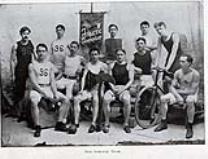 Chester is in the back row, First from the left |
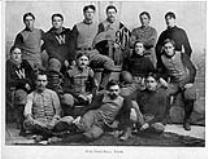 Chester is in the middle, behind the “86” sign. |
However, his sports skills were not what got him noticed at WPI. His drawing skills got a lot of attention from his peers. He excelled in freehand drawing and technical drawing. Fellow students envied his talent. They were discouraged when they compared their work to Chester’s.(3)
He used his artistic talents to contribute to the production of the 1896 yearbook. Along with another student, he was responsible for the illustrations.
(Chester’s illustrations in the 1896 Yearbook)
Chester’s future seemed to be decided already. In the 1896 yearbook, it mentions that Chester must have blood from Izaac Walton (1593-1683) «Issac Walton» (1593 – 1683) in his veins, because the Institute’s activities never interfered with his personal work. (3)
Even with his electrical engineering diploma in hand, he preferred working for his father and becoming a taxidermist to dedicate his life to birds and nature study.

In January 1895, his father, Charles K. Reed, published the following ad in “The Museum” magazine. (4)
«I WANT a first class camera 4 x 5 or 5 x 8 will give a good exchange in mounted birds skins, eggs or supplies. Describe what you have and what you want for it.»
CHAS. K. REED, Worcester, Mass.
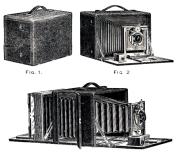
In June 1896, at his graduation, Chester received a “Premo” camera (1), probably a gift from his father to commemorate the end of his studies.
That camera marked the beginning of his professional career in ornithology.
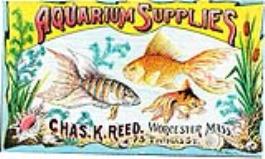
On the 1900 census, it indicates that Chester’s occupation was taxidermist and artist. A few years later, it indicates that he was a book designer and a magazine illustrator. One of his first clients was probably his father, Charles. Chester made the drawing for this small guide in 1897, which provided information on general aquarium maintenance rules, including recommendations for different fish species. (P8)
This header shows the orientation that he took in his career. (P9)
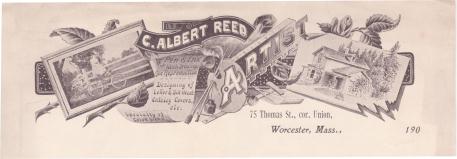
It says: pen & ink and wash drawings for reproduction, designing of letter & bill heads, catalogue covers, etc., specialty in color work.
To know some more, consult question 3 in the section “For most curious”
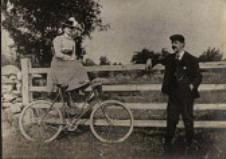
Two pictures stand out on the header. They show the importance that Chester gave to family values. The picture on the right shows his grandparents’ house, on his father’s side. The picture on the left shows Eva Melissa Himes (1880 – 1934) two years before their wedding.(P10)

Chester, aged 24, married Eva Melissa Himes, aged 20, on June 6, 1900, in Worcester, Massachusetts. The wedding was performed by Roland A. Nichols, Minister of the Gospel.(5) This picture was taken in 1898. (P11)
Chester and Eva had one child, Mertice Elaine Reed, born on February 3, 1902, in Worcester. In an interview for the newspaper Worcester Sunday Telegram on July 31, 1960, (6) Mertice remembers that her father would often work late at night to compile his observation notes from the day, print out his nature photographs, finish his color drawings and work on his texts for articles or for his books. He spent most of his leisure time observing birds.
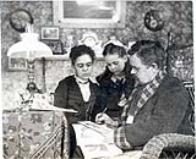
Even though her father dedicated a lot of time to his work, Mertice keeps the memory of a generous father, a very attentive person who, sometimes, would bring waltzing mice home for her. He was always available to share his passion for birds and the joys of nature. In this picture, taken in 1910, Chester was having a short drawing session with Mona, in the middle and Bertha, Chester’s sisters. (P12)
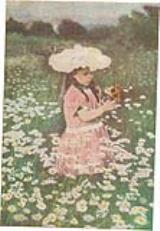 In 1910, Chester published a book on flowers: Wild Flowers East of the Rockies. He dedicated the book to Mertice with the mention below:
In 1910, Chester published a book on flowers: Wild Flowers East of the Rockies. He dedicated the book to Mertice with the mention below:
To Mertice Elaine
The little «Flower Girl» in the Frontispiece,
This Book is Affectionately Inscribed.
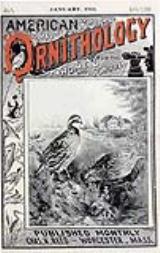
Chester’s career took off with the publication of his first ornithology magazine, American Ornithology for the Home and School, dedicated to education and bird conservation, published on January 1, 1901. The magazine marked the beginning of his bright career in articles and book writing as well as conferences on ornithology and nature in general. The magazine was published from January 1st, 1901 to August 1906, totalling more than 1,500 pages of articles, drawings and pictures on ornithology. (23)
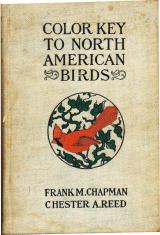
Publishing the magazine was an opportunity for Chester to become popular among ornithology enthusiasts and specialists of the time. In February 1902, Mr. Frank M. Chapman contacted Chester and his father Charles to publish his book “Color Key to North American Birds.” (24) It was the first book to show the birds by groups of similar colors. The drawings were not an exact reproduction of the birds, but aimed to highlight the spots of color that helped to identify the birds from a distance, by the naked eye, without having to bring them down. Chester produced over 800 drawings for the project. (For more information about the book, consult the section “Color Key to North American Birds.” (P25)
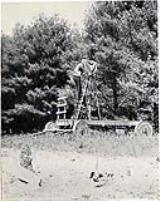
Chester practiced photography since 1896. His magazine “American Ornithology for the Home and School” allowed him to show his pictures and, starting in 1902, he suggested writing articles on the photography of birds. In 1911, he published a 310-pages book entitled “Camera Studies of Wild Birds in Their Homes,” with over 200 pictures. The photography of birds required a lot of ingenuity and patience from the photographer to achieve good pictures. His book initiated amateurs to the practice. (P15)
At the American Ornithologists’ Union (AOU) association’s annual meeting on November 28, 1904, Chester became a member of the prestigious organization. (15) Interesting fact: Chester’s parents were also members of the association. His father, Charles, was a member from 1890 to 1894 (16)and his mother, Carrie, from 1925 to 1941. (17) For them, ornithology was a family history.
Chester always enjoyed communicating and sharing his knowledge. From 1904 to 1909, he was a teacher and speaker at the Worcester Natural History Society. On March 18, 1906, (6) Chester gave a presentation to an audience of 300 people. On March 25, 1906 (7), he spoke to an audience of 700 students, boys and girls, aged 10 to 15 years old, about tits and nuthatches. He used his drawings and pictures to bring his conferences to life. His presentations for children often took place at the Museum of Worcester, at 3 p.m., after school. (P16)
On March 12, 1909, his conference for adults was well appreciated by his audience. Professor J. H. Emerton, expert on spider studies and secretary of the New England Federation of Natural History Societies, came to Boston expressly to listen to Chester and see his drawings. (8) The invitations were advertised in local newspapers. Sometimes, the museum’s administrators sent out more formal invitations.
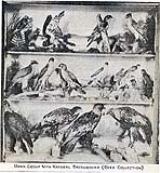
In 1907, Mrs. Eliza D. Dodge, the wife of the Honorable Thomas H. Dodge, acquired the Reed Collection for a total of $1,500 and handed the precious collection over to the Worcester Natural History Society. Mr. Edward Howe Forbush inspected the collection and said that the Museum was very lucky to own it. (9) In 20 years, Chester and his father had put together 468 specimens representing 236 bird species. If they were different, the male, female and young birds were preserved and mounted carefully to help bird study in the area. A letter confirms the sale. (P17)
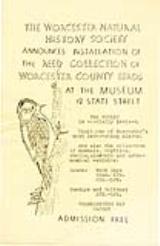
The collection was shown at the Worcester Natural History Society and, later, transferred to the Green Hill Mansion, a better space for the large collection. When the hall closed, in the early 1960’s, part of the collection was transferred to the Museum and another part, including specimens that Mr. Edward Howe Forbush had given to the museum, were loaned to schools for educational purposes. (11) (P18)

In 1908, Chester replaced Mr. Edward Howe Forbush, who was officially named “State Ornithologist,” (12) as the curator for the Worcester Natural History Society museum. He held the position all his life, while helping his father at the store, in a less diligent way. (P19)
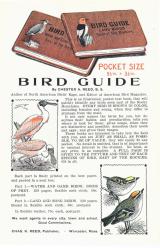
From 1901 to 1912, Chester published 27 books. The ones that marked the history of ornithology were the series “Bird Guides,” published in 1905 and 1906. The books have been re-edited until the beginning of the 1960’s. (18) (P20) (18)
..
The fifth book of the collection, “Western Bird Guide,” was edited a few months after his death.
Chester had a great passion for birds, but he also had other interests. He published books on flowers, on his observations of nature (insects, frogs, animals, etc.), on taxidermy, and an innovative book on the use of a camera to take pictures of birds.
Nowadays, on websites specialized in used or rare books, we can still buy original books written by Chester. Some companies have even offered the reprinting of his books more than 100 years after their first edition. These books are still sold all around the world.
The exact list of publications is available in the section “List of Chester A. Reed’s publications.”
In a correspondence with Mr. Frank M. Chapman on February 15, 1902 (13), Chester mentioned that he wished he could travel like Mr. Chapman and that, one day, he would travel to the Orinico and go down the Amazon (two rivers of South America).
After having traveled in the West of America for a part of the summer and spending the fall of 1912 studying, drawing and taking pictures of birds 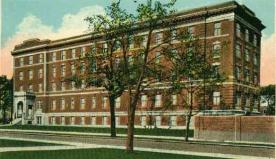
in preparation for his book “Western Bird Guide,” Chester was getting ready to fulfil his dream: a trip to South America. (1) He had already booked his spot on a steam boat when he caught the flu that led to pneumonia. He was then admitted to the Memorial Hospital, where he passed away on December 16, 1912, at 10:21 p.m., at age 36. (21) The funeral service took place at the family home on December 19th, at 2:00 p.m. A delegation from the Worcester Polytechnic Institute attended the service. He was buried at the Hope Cemetery in Worcester. (22) (P24)
In the magazine “Bird-Lore”, edited by Frank M. Chapman in February 1913, Mr. Chapman highlights the importance of Chester’s unique contribution of sharing his knowledge of birds through his books and drawings. He had an unusual ability to discover birds’ wild life. (19)
In April 1913, “The AUK,” the American Ornithologists’ Union’s magazine, (20)recognized that, at his young age, Chester had gained a big reputation and had impressive skills for using his camera and his paintbrushes. He had largely contributed to the expansion of popular knowledge of bird life through his publications. The magazine mentions that Chester thought early of producing color drawings of birds, to help people familiarize themselves with birds and provide drawings of real dimensions. It was his main concern.
In the death of Chester A. Reed of Worcester, Mass., on December 16, 1912, the Union lost an Associate of much promise. While only thirty-six years of age Mr. Reed had already attained a wide reputation by his publications on popular bird study. He early conceived the idea that colored illustrations were the surest means of obtaining a familiarity with birds and in all his works, the furnishing of adequate illustrations was the chief aim.
The AUK, April 1913.
Chester died very young and did not have time to enjoy his reputation. He shared his passion of birds with millions of ornithology enthusiasts and professionals. He had a passion for drawing and photography, but his passion for sharing his discoveries will be his legacy. We can still feel his influence today.
Chester Albert Reed wrote an important page in the history of the ornithology hobby in America. We should remember him.
He deserves the title of pioneer in the ornithology hobby in America.
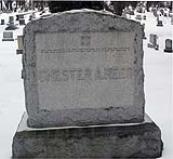
Chester Albert Reed 1876 – 1912 Hope Cemetary
Here is the slide show of the presentation.
Information sources:
(1) Worcester Sunday Telegram, July 31, 1960, “Worcester’s Own Audubon” by Frances Green.
(2) WPI Archives
(3) WPI Archives – 1896 Yearbook
(4) The Museum, January 1895, page 65
(5) Marriage Record – Worcester, Massachusetts, 1900, Vol. 502, Page 426.
(6) Worcester Sunday Telegram, March 18, 1906
(7) Worcester Sunday Telegram March 25, 1906
(8) Reed family archives
(9) Worcester Sunday Telegram, July 31, 1960
(10) Worcester Sunday Telegram, February 23, 1907
(11) Worcester Sunday Telegram, May 29, 1966
(12) MAY, J. B. (1928) Edward Howe Forbush: A biographical sketch. Proceedings of the Boston Society of Natural History, 1928
(13) Archival material from Department of Ornithology American Museum of Natural History, New York.
(14) www.ancestry.com: ID: I73728
(15) The AUK, “The American Ornithologists’ Union” magazine, Vol. 22, 1905, page 74
(16) List of members, The AUK, “The American Ornithologist’ Union” magazine, 1891
(17) Palmer, T. S. (Theodore Sherman), 1868-1955. Biographies of members of the American Ornithologists’ Union, by T.S. Palmer and others. Washington: [s.n.], 1954. page 472.
(18) America Ornithology after Audubon, Mark V. Barrow, Jr., Princeton University Press, 1998, page 158.
(19) Bird-Lore, edited by Frank M. Chapman, Vol. 15, February 1, 1913, No 1.
(20) The AUK, “The American Ornithologist’ Union” magazine, Vol. 30, 1913, page 319
(21) Worcester Sunday Telegram, December 17, 1912
(22) Worcester Sunday Telegram, December 20, 1912
(23) Presentation by Carrie B. Reed in a biographical summary, March 30, 1910, family Reed’s archives.
(24) Correspondence between Charles K. Reed and Mr. Frank Chapman, February 12, 1902. Archives from the Department of Ornithology American Museum of Natural History, New York.
Pictures:
(P1) : Chester as a teenager, Reed family archives.
(P2) : Graduation picture of Chester from the Worcester Polytechnic Institute in 1896, Worcester Polytechnic Institute archives.
(P3) : Year Book 1896, WPI Archives
(P4) : Year Book 1896, WPI Archives
(P5) : Year Book 1896, WPI Archives
(P6) : Year Book 1896, WPI Archives
(P7) : The Museum, January 1895, Vol. 1, No 3.
(P8) : Reed family archives.
(P9) : Reed family archives.
(P10): Reed family archives.
(P11): Reed family archives.
(P12): Reed family archives.
(P13): Wild Flowers East of the Rockies, Chester A. Reed, 1910
(P14): American Ornithology for Home and School,
January 1901, Vol. 1. No 1.
(P15): American Ornithology for Home and School,
September 1902, Vol. 2. No 9.
(P16): Reed family archives.
(P17): Sunday Telegram, October 27, 1935
(P18): Reed family archives.
(P19): Reed family archives.
(P20): «American Ornithology for Home and School» May 1906
(P21): Elaine Pajka, from «Hope Cemetary» Worcester
(P22): Ecotarium archives, Worcester, archives
(P23): Source: www.historiccamera.com
(P24) : Memorial Hospital, Worcestermass.com
(P25): “Color Key to North American Birds” by Frank M. Chapman and Chester A. Reed.